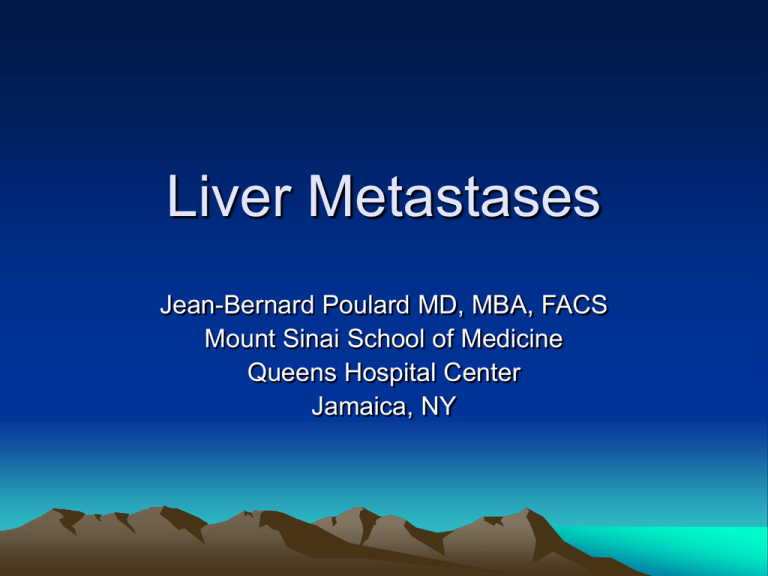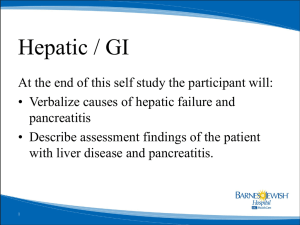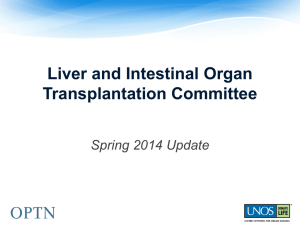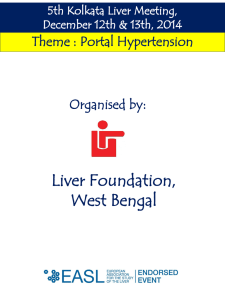Liver Metastases
advertisement

Liver Metastases Jean-Bernard Poulard MD, MBA, FACS Mount Sinai School of Medicine Queens Hospital Center Jamaica, NY Liver Metastases Liver Metastases • 30 Years Ago, Considered Incurable Liver Metastasis • • • • • • • • Extent of the problem Primary Cancers and Mets Liver structure and function considerations Excision and its evolution Chemo as an adjunct Ablative Approaches Current Recommendations The Future Liver Metastases- Biology • • • • • • Fertile Circulation. Systemic and Portal Biliary Component Primary Drainage for GI Tract /Pancreas Functional Importance Regenerative Capacity Abused and Insult (alcohol and Viruses) Liver Mets- Extant of Problem • • • • • Demographics of Colorectal Cancer Other Gastro-Intestinal Cancers Other Sites Sites Where Treatment Benefits Sites with No Benefit Liver Metastases Practical Considerations • • • • • • • Function Accessability Resectability Technical Considerations (Support) Equipment and Machinery Surgical and Interventional Expertise Critical Care Liver Mets -Metastasectomy • • • • • • • • Indications Tissue Diagnosis Size and Number and Lobes Timing Chemo Pre-Resection? Risks Morbidity and Mortality Outcome Liver Mets - Metastasectomy • • • • Extra-Hepatic Disease: Containdication? Used to Be But if Extra-hepatic and Mets Resectable If R0 Possible – 5 yr 29-38% (Elias et al, BJS 2003; 90: 567-74) Liver Metastases-HAI • Rationale for Hepatic Artery Infusion – Not Amenable to Excision • • • • Technical Considerations Risks and Pitfalls (misperfusion, Art Injury) Evolution and Current Practice Chemo Agents: 5-FUDR (+ leucovorin and Dexamethasone), – Results: RR 78%, Median Survival 25 mos Kemeny N. J Clin. Onc. 1994; 23:2288 Liver Metastases HAI 2 • Oxaliplatin and Irinotecan – Scant Data but Safe via HA – 28 Pts with Isolated Liver Mets – Oxaliplatin Followed by IV 5-FU and Leucovorin – Objective RR 64% Median Survival 28 Mos J. Clin. Onc. 2005; 23:275s Liver Metastases-Ablation 1 • Indications • Modalities – Intratumoral, Cryo, Radiation, Thermal • Common Attributes • Degree of Invasiveness Liver Metastases- Intratumoral • • • • • • Percutaneous Ethanol and Acetic Acid Used in small HCC (Japan) Difficult Access for Some Lesions Etoh not Effective in Other Histologies Consensus: Etoh not Appropriate Acetic Acid Liver Metastasis - Cryoablation • Techniques • Failure Rate: 10-44% (Most in Non-Frozen sites) • Sometimes after Incomplete Excision • Survival 24-38% 5 year • Drawback: Requires Laparotomy • Obsolescent? Liver Metastases- Radiation • External Beam Therapy Limited – Tolerance 35 Gy vs 70 Gy to Destroy CA • Stereotactic for Small Tumors • Brachytherapy : I-125 Seeds Rarely used after Incomplete Excision – Complex Logistics, Cryo Preferred • Radioembolization • Y-90 tagged Resin or Glass microspheres • Used with HAI of FUDR (RR 44 vs 18) • Similar Toxicity, No Signicant Survival Benefit (Xcpt>15) Ann. Onc. 2001; 12: 1711 Liver Metastases Thermal Ablation 1 • Modalities – Radiofrequency Ablation – Laser and Microwaves (Europe) • Limitations – Control of Margin – Specificity of Tissue Damage • Advantage – Percutaneous Approach Liver Metastases • Radiofrequency Generator Liver Metastases -RFA • Used in HCC and Liver Mets • Open, Laparoscopic or Percutaneous – Relation to Recurrences – Experience, Type of Equipment • Pitfalls: Intestinal and Diaphragm Injuries Portal Vein Thrombosis • Mortality 0-2% Major Complications 6-9% • Outcome: Median Survival 24 Months Liver MetastasesRecommendations • Resection for Cure is First Option • Potentially Resectable if Lesions Smaller – Systemic Chemo and Reevaluation • Limited Number of Mets but Not Surgical Candidate: – Ablation (RFA Preferred) – HAI Liver Metastases- The Future CRC • The M.D. Anderson’s Approach • Up to 1992, 35% Survival for Stage 4 CRC • Post 1992, Up to 58% – Anesthesia, Surgery, Hemostatics, Imaging, Intesive Care • Surgical Excision as Primary Tx –Better • Chemo Alone or RFA <20% • Solitary Met Excision 71% Survival 5 Yrs Liver Metastasis- The Future 2 CRC • Majority are Unresectable at Presentation • Make Them Resectable? • Prospective Trial – Combination Chemotherapy – Staged Hepatectomy – Portal Vein Embolization • Determine Remnant of Viable Liver • Size and Number of Mets not Factor Liver Metastases – The Future 3 CRC • Response Rate to Cytotoxic with Biologic – Up to 50% • Portal Vein Embolization – Induces Increase in Volume of the Liver – Increases the Function • Regeneration – 2-4 Weeks in Normal Liver – 6-8 Weeks for Diabetics and Cirrhotics Liver Metastases- The Future 4 CRC • • • • • • • • • Stage Resection For Bilateral Lobe Involvement Chemo- Excise From one Lobe PVE – Liver Regenaration Resect from Other Lobe Survival 40% 80% of Liver Volume can be Resected Use 3-D CT Volumetry Surgical Mortality .8% Liver Metastases Prevention? • Stage 2 and 3 CRC • Hepatic and Regional Chemo Before Surgery • Randomized, No significant Morbidity • Time to Liver Mets 16 vs 8 mos. • Incidence 20.6 vs 28.3 • Disease Free Survival 74vs 58.1 (3 yr) • Overall 87.7 vs 75.7 • No Benefit for Stage 2 Xu et al. Ann Surg. 2007; 245:583-90 Liver Metastases Gastric Cancer • • • • Hepatic Metasectomy done Rarely Isolated Liver Involvement Rare (.5%) Long Term Survival is Rare Non-RandomIzed Series 37 patients -HAI – 5 FU chemo – Gastrectomy and HAI – Better Response – But No Increase Survival Ojima et Al. World J Surg. 2007; 5: 70 Liver Metastases Final Word • • • • Screen, Screen, Screen for CRC Polypectomy may be Preventive Early Cancers are Curable Have you Had Your Colonoscopy? • Thank You








